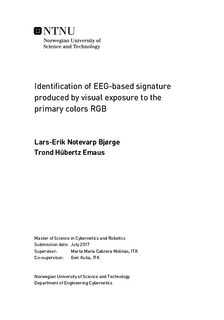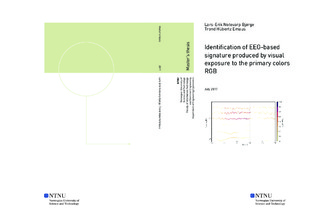| dc.contributor.advisor | Molinas, Marta Maria Cabrera | |
| dc.contributor.advisor | Kulia, Geir | |
| dc.contributor.author | Emaus, Trond Hübertz | |
| dc.contributor.author | Bjørge, Lars-Erik Notevarp | |
| dc.date.accessioned | 2017-10-05T14:01:24Z | |
| dc.date.available | 2017-10-05T14:01:24Z | |
| dc.date.created | 2017-07-04 | |
| dc.date.issued | 2017 | |
| dc.identifier | ntnudaim:17814 | |
| dc.identifier.uri | http://hdl.handle.net/11250/2458799 | |
| dc.description.abstract | In this thesis we have presented results for experiments regarding identification of electroencephalograph (EEG) signatures produced by the visual exposure of primary colors i.e. red, green and blue (RGB) to the subject. The experiments are conducted with an open-source Brain-Computer Interface (BCI) called OpenBCI with the help of 10 healthy participants. The reason for the study is to see if there are any clear brain-wave patterns in the EEG data by looking at characteristics between the different colors and individuals.
Regarding data analysis, a well-known signal analysis technique called Hilbert-Huang Transform (HHT) has been applied to the EEG data. The algorithm uses Empirical Mode Decomposition (EMD) to break the signal into meaningful Intrinsic Mode Functions (IMF). By executing Hilbert Transform (HT) on the IMFs, instantaneous frequency and amplitude is obtained. These instantaneous frequencies are examined by using Hilbert Spectral Analysis (HSA), to get a qualitative visual representation. As for the steady-state experiment, Fourier transform has been applied to acquire spatial information.
A significant difference was found between exposure to the different colors. Exposure to the color blue seems elicit a considerably narrower frequency band with a larger amplitude than that of the color red and green. Moreover, the frequency response for color green showed a frequency shift towards higher frequency compared to that of the red and blue color. The individual differences were quite significant, and it seems that the brain responses varies a lot across all of the subjects. From these results, we can conclude that OpenBCI is well-suited for recording complex EEG data, and may be utilized for several applications without the need of more expensive equipment for recording EEG data. | |
| dc.language | eng | |
| dc.publisher | NTNU | |
| dc.subject | Kybernetikk og robotikk (2 årig), Roboter og fatøystyring | |
| dc.title | Identification of EEG-based signature produced by visual exposure to the primary colors RGB | |
| dc.type | Master thesis | |

